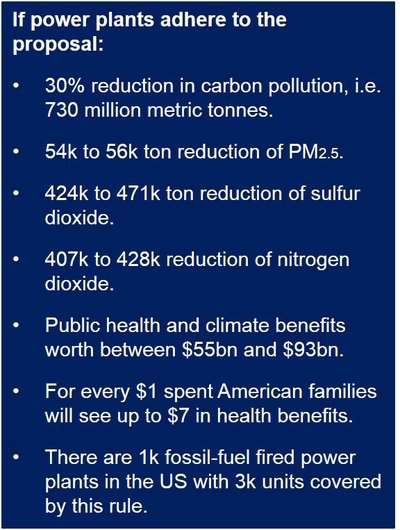The Clean Power Plan proposal released on Monday – the US guidelines to cut carbon emissions from existing power plants – is aimed at ensuring a healthier environment, spurring innovation and strengthening the economy, the Environmental Protection Agency (EPA) said on Monday.
The EPA says its proposal is ‘flexible’ and is aimed at reducing carbon pollution from its single largest source – existing US power plants. If existing power stations comply, Americans will enjoy a cleaner environment, the country will be contributing more effectively towards halting climate change, and the population will receive reliable and affordable power, the EPA added.
EPA Administrator Gina McCarthy, said:
“Climate change, fueled by carbon pollution, supercharges risks to our health, our economy, and our way of life. EPA is delivering on a vital piece of President Obama’s Climate Action Plan by proposing a Clean Power Plan that will cut harmful carbon pollution from our largest source–power plants.”
“By leveraging cleaner energy sources and cutting energy waste, this plan will clean the air we breathe while helping slow climate change so we can leave a safe and healthy future for our kids. We don’t have to choose between a healthy economy and a healthy environment–our action will sharpen America’s competitive edge, spur innovation, and create jobs.”
One third of carbon emissions come from power plants
In the US, power plants are responsible for approximately one-third of all greenhouse emissions. There are currently no limits on carbon pollution levels emitted by power stations in the United States, although there are for levels of nitrogen oxides, particle pollution, sulfur dioxide, mercury and arsenic.
According to the EPA, “This proposal follows through on the common-sense steps laid out in President Obama’s Climate Action Plan and the June 2013 Presidential Memorandum.”
Targets for 2030
If adhered to completely, by 2030 the ETA guidelines will:
- Reduce power sector carbon pollution by 30% across the country, equivalent to powering half the homes in the US for six months.
- Reduce sulfur dioxide, nitrogen and particle pollution by over 25%.
- Prevent up to 150,000 childhood asthma attacks, up to 490,000 missed work/school days, and up to 6,600 premature deaths.
- Save up to $93 billion in climate and public health costs.
- Reduce electricity bills by about 8% due to better energy efficiency and lower demand in the electricity system.
The EPA wrote:
“The Clean Power Plan will be implemented through a state-federal partnership under which states identify a path forward using either current or new electricity production and pollution control policies to meet the goals of the proposed program.”
Programs can be tailor-made
US states are invited to develop plans to meet state-specific goals to reduce carbon emission. Each state can tailor a program that takes into account its unique situation. They can either work alone or together with other states to develop multi-state plans.
(Source: EPA Fact Sheet – Clean Power Plan)
The EPA says today’s proposal has a flexible timeline for states to follow when submitting their plans, which are due in June 2016. There is an option of using a two-step process if more time is required.
The EPA wrote “States that have already invested in energy efficiency programs will be able to build on these programs during the compliance period to help make progress toward meeting their goal.”
The American Wind Energy Association (AWEA) reminded its citizens that wind energy can reduce C02 emissions from power plants. The AWEA added that every state in the country is already enjoying reduced emission, partly thanks to wind energy.

